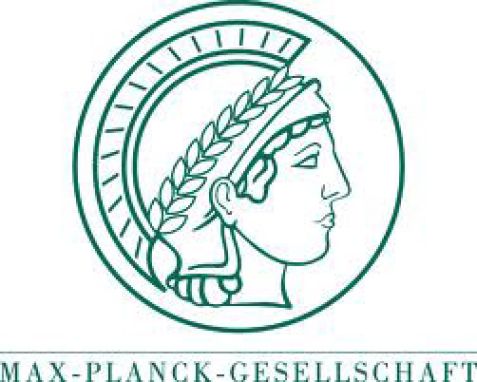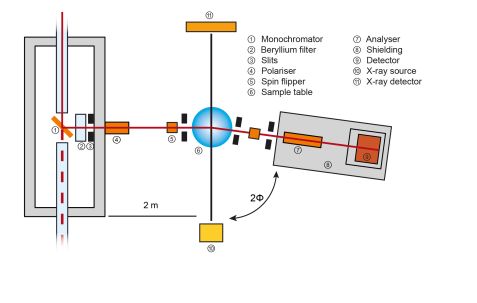MLZ is a cooperation between:
 > Technische Universität München
> Technische Universität München > Helmholtz-Zentrum Hereon
> Helmholtz-Zentrum Hereon
 > Forschungszentrum Jülich
> Forschungszentrum Jülich
MLZ is a member of:
 > LENS
> LENS > ERF-AISBL
> ERF-AISBL
MLZ on social media:

MLZ (eng)
Lichtenbergstr.1
85748 Garching
NREX
Polarised neutron reflectometer with X-ray option

Dieses Instrument ist auf kalte Neutronen fokussiert. Bitte beachten Sie deshalb aktuell die „Technischen Daten OHNE kalte Quelle“ unten. Wichtige abweichende Parameter sind gefettet. Ihre Rückfragen werden gern vom Instrumentteam beantwortet.
The neutron/ X-ray contrast reflectometer NREX is designed to determine structural and magnetic properties of surfaces, interfaces, thin films, and heterostructures.
A focussing multiblade monochromator allows for measuring small area (20 mm2) samples with high polarisation in a dynamic range of six orders of magnitude. For larger samples and a non-polarised beam, more than seven orders are feasible. A horizontal alignment of the sample allows for performing (a) GISANS (grazing incidence small angle neutron scattering) and GIND (grazing incidence neutron diffraction) and (b) in-situ X-ray experiments. For the latter, an optional X-ray reflectometer is mounted perpendicular to the neutron beam. Simultaneous neutron/ X-ray experiments allow for effective studies of irreversible processes and sensitive samples.
A (polarised) neutron reflectometry alone or in combination with X-ray reflectometry provides information about spatial distribution of chemical elements and isotopes and magnetic moment.
A selected list of examples:- Interface phenomena in strongly correlated heterostructures
- Model surfaces for biofunctional studies
- Physics and chemistry of liquid/ solid and gas/ solid interfaces
- New materials for spintronic, quantum, and neuromorphic computing
- Influence of reduced dimensionality on magnetic properties
- Soft thin films
- Material science of thin films and heterostructures
- Closed cycle cryostat (down to 3.5 K) with low background sapphire windows
- 3He cryostat (down to 0.5 K), bottom loaded with large sample space
- Electromagnet (up to 3.5 T) with versatile field direction in x, y and z
- In-situ X-ray reflectometer
- Gas tight chamber with controllable atmosphere (H2, H2O, Ar, N2, etc.) and temperature (up to 600 K)
- Humidity control system; Humidity 0 – 100 % (H2O or D2O), temperature 20° C < T < 50° C
- High voltage sample stick (up to 10 kV)
- In situ transport measurement
- γ-detector for surface prompt-gamma analysis
- Type: 7 × 5 HOPG crystals, horizontal focussing
- Wavelength: 3.0 Å fix
- Wavelength resolution: 1…2 %
- Distance to sample: 2500 mm
- Vertical
- Slit sizes: 0.2 – 6 mm
- Divergence: 0.05 – 1.4 mrad
- Horizontal
- Slit: 0.2 – 100 mm
- Double-bounce polariser with bandpass coating supresses higher monochromator orders: P: > 99.9 %
- Analyser with 200 × 200 mm² entrance area: P > -99.0 %
- Compensation for the reduced flux is awaited
- Flipper efficiency: > 99.99 %
- 2 pencil detectors: 3He
- 2D area detector: 3He wire chamber
- Active area: 200 × 200 mm2
- Lateral resolution: 3 mm
- Distance to sample: 2465 mm
- Non-polarised: 3 × 105 n cm-2 s-1
- Polarised: 1 × 105 n cm-2 s-1
- Specular reflectivity: 1 : 1 × 10-6 (@ 5 × 5 mm² sample and full polarization)
- Limits of Q-components (for λ = 2.9 Å)
- Qz: 0.0075 – 0.75 Å-1
- Qx: 7.5 × 10-5– 7.5 × 10-3 Å-1
- Qy: 0.03 – 2.3 Å-1
- Source: Cu-Kα fixed anode (1.54 Å)
- Monochromator: Göbel Mirror & Double Ge-Crystal
- Detector: 1-dimensional DECTRIS
- Type: 7 × 5 HOPG crystals, horizontal focussing
- Wavelengths: 4.1 – 5.5 Å, best flux/ underground with Be filter at 4.3 Å
- Wavelength resolution: 1…2 %
- Distance to sample: 2500 mm
- Vertical
- Slit sizes: 0.2 – 6 mm
- Divergence: 0.05 – 1.4 mrad
- Horizontal
- Slit: 0.2 – 100 mm
- Double-bounce polariser with bandpass coating supresses higher monochromator orders: P: > 99.9 %
- Analyser with 200 × 200 mm² entrance area: P > -99.0 %
- Flipper efficiency: > 99.99 %
- 2 pencil detectors: 3He
- 2D area detector: 3He wire chamber
- Active area: 200 × 200 mm2
- Lateral resolution: 3 mm
- Distance to sample: 2465 mm
- Non-polarised: 3 × 105 n cm-2 s-1
- Polarised: 1 × 105 n cm-2 s-1
- Specular reflectivity: 1 : 1 × 10-6 (@ 5 × 5 mm² sample and full polarization)
- Limits of Q-components (for λ = 2.9 Å)
- Qz: 0.0075 – 0.75 Å-1
- Qx: 7.5 × 10-5 – 7.5 × 10-3 Å-1
- Qy: 0.03 – 2.3 Å-1
- Source: Cu-Kα fixed anode (1.54 Å)
- Monochromator: Göbel Mirror & Double Ge-Crystal
- Detector: 1-dimensional DECTRIS
Instrument scientists
Dr. Laura Guasco
Phone: +49 (0)89 289-14769
E-mail: L.Guasco@fkf.mpg.de
Dr. Thomas Keller
Phone: +49 (0)89 289-12164
E-mail: T.Keller@fkf.mpg.de
Prof. Dr. Bernhard Keimer
Phone: +49 (0)711 689-1650
E-mail: b.keimer@fkf.mpg.de
NREX
Phone: +49 (0)89 289-14878
Operated and funded by

Publications
Find the latest publications regarding NREX in our publication database iMPULSE:
Citation templates for users
In all publications based on experiments on this instrument, you must provide some acknowledgements. To make your work easier, we have prepared all the necessary templates for you on this page.
Gallery



MLZ is a cooperation between:
 > Technische Universität München
> Technische Universität München > Helmholtz-Zentrum Hereon
> Helmholtz-Zentrum Hereon
 > Forschungszentrum Jülich
> Forschungszentrum Jülich
MLZ is a member of:
 > LENS
> LENS > ERF-AISBL
> ERF-AISBL
MLZ on social media:



